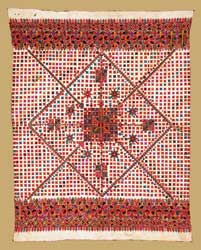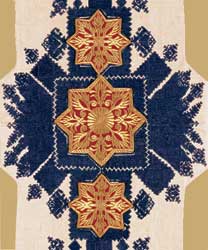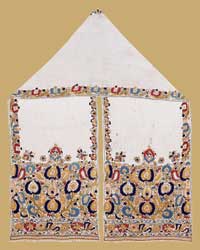
|
Women of wealth were taught to embroider at a young age and, over the years, they accumulated many pieces to be displayed or worn at special occasions. Once married, they continued to embroider at home or, in some cases, in harems, where they mingled with other women, exchanging ideas, dreams and technical expertise. Embroidery played an important social and economic role in northern Morocco, and each city developed its own distinct and varied style. Wealthy families exhibited their status through the use of exotic fabrics, elaborate decoration and abundant jewelry. Clothing and other textiles in Morocco exhibit the complex aesthetics found throughout the Muslim world. Islamic art, including textile arts, is defined by visual intricacy and by a preference for abstraction and repetition, rather than literal subject matter. In the embroideries of Morocco, the freedom with which the motifs are arranged, the variety and elegance of the compositions, and the exquisite color sense they reveal are evidence of their absolute originality. Click on images for more information. |
||

Carrying cloth (mendil) |

Detail of Hanging (arid) |

Mirror cover (tensifa) |

Cushion cover |
Woman's belt (hezam) |

Hanging (arid) |
|
|

Chest cover |
|
|
Introduction | Urban Textiles and Costumes | Rural, Part One / Part Two | Education |
||
 Morocco's cultural traditions, although deeply rooted in Islamic and Berber customs, have been enriched over the centuries by other cultures, particularly Jewish, African and Mediterranean. For hundreds of years, Moroccan women have composed fine embroideries and rugs using intricate designs that have been passed down through generations. Embroidery--chiefly an art of Morocco's cities--developed gradually over several centuries as a consequence of foreign settlement, interaction and trade, and these textiles are among the highest artistic achievements of the region.
Morocco's cultural traditions, although deeply rooted in Islamic and Berber customs, have been enriched over the centuries by other cultures, particularly Jewish, African and Mediterranean. For hundreds of years, Moroccan women have composed fine embroideries and rugs using intricate designs that have been passed down through generations. Embroidery--chiefly an art of Morocco's cities--developed gradually over several centuries as a consequence of foreign settlement, interaction and trade, and these textiles are among the highest artistic achievements of the region.